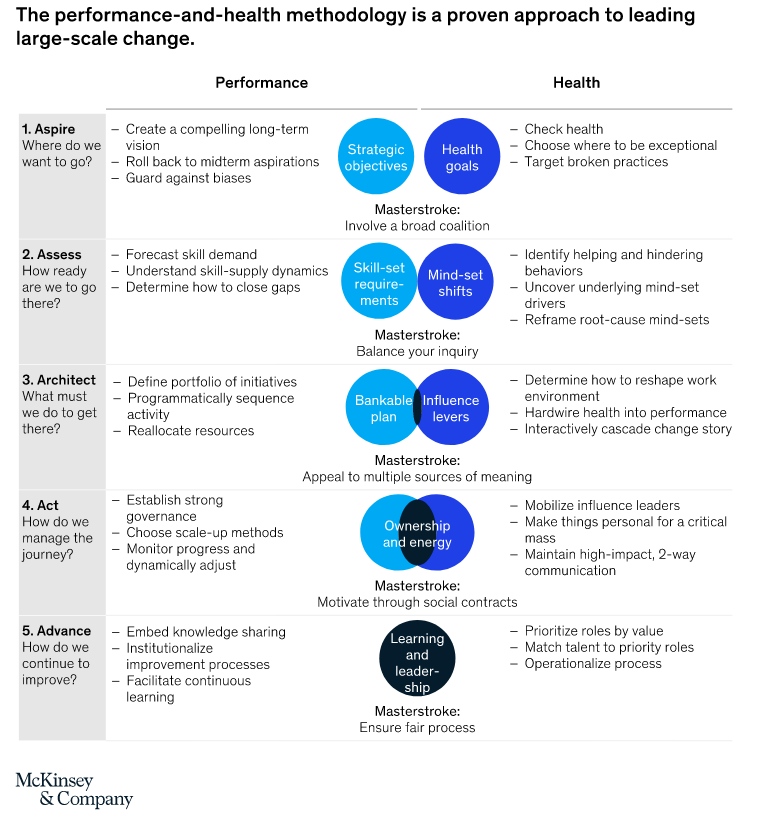Framework 171 Performance and Health Methodology (5As)
Introduction
This is about 5 frames of performance and health that divides the overall change journey into smaller, more manageable stages, ie aspire, assess, architect, act and advance.
Each stage there are some basic questions that need to be answered
"...- Aspire (Where do you want to go?)
- Assess (How ready are you to go there?)
- Architect (What must you do to get there?)
- Act (How do you manage the journey?)
- Advance (How do you continue to improve?)..."
Scott Keller et al, 2019
While the health of an organisation is based on its
"...ability to align around a clear vision, strategy, and culture; to execute with excellence; and to renew organisations focus over time by responding to market trends..."
Aaron De Smet et al, 2014
There are 9 dimensions to health
i) direction
ii) accountability
iii) coordination and control
iv) external orientation
v) leadership
vi) innovation and learning
vii) capabilities
viii) motivation
ix) culture and climate
More details on some dimensions
- direction (shared vision, strategic clarity, employee involvement, etc)
- accountability (role clarity, performance contracts, consequence management, personal ownership, etc)
- motivation (meaningful values, inspirational leadership, career opportunities, financial incentives, rewards and recognition, etc)
Framework for performance
"...- Strategic objectives (aspire) (create a compelling long-term vision, said mid-term aspirations along the path, and guard against bias is in the process)
- Skill-set requirements (assess) (forecast demand for skills and understand their supply dynamics; and then decide how to close gaps)
- Bankable plan (architect) (five portfolio of initiatives that will realise your strategic objectives and meet your skill requirements; then sequence your actions and reallocate resources accordingly)
- Ownership model (act) (establish strong governance, decide how to scale your change initiative, monitor their progress, and dynamically adjusts them through implementation)
- Learning infrastructure (advance) (institutionalise processes and expertise so that the organisation shares knowledge, constantly approves, and continually learns to do new thing)..."
Scott Keller et al, 2019
Framework for health
"...- Health goals (aspire) (objectively check your organisation's health, choose where to be exceptional, and target areas that need immediate improvement)
- Mind-set shifts (assess) (pinpoint helping and hindering behaviours for priority health areas, explore the underlining mind-set drivers, and prioritise a critical few 'from-to' mind-set shifts)
- Influence levers (architect) (used 4 levers to reshape the work environment: role modelling, understanding and conviction, reinforcement mechanisms, and confidence-building efforts. These ensure that performance initiatives are engineered to provide the necessary mind-set and behavioural shifts)
- Generation of energy (act) (mobilise influence leaders, make the change personal for employees, and maintain high-impact, two-way communication.)
- Leadership placement (advance) (prioritise ongoing roles by their potential to create value, match the most important ones to the best talent, and make sure talent-match process business as usual)..."
Scott Keller et al, 2019
NB The advanced stage lays the foundations to repeat the 5 frame cycle.
Integration of performance and health
The integration of performance and health is important. Need to resist the tendency for the the business to do the 'performance stuff' and HR to do the 'health stuff'; if this separation happens, it will reduce the chance of a successful change initiative.
"...In the aspire stage, the work related to each element of performance and health is relatively self-contained. Later on, as a work move from planning to action, efforts to boost performance increasingly reinforce health, and vice versa. By the act stage, employees experience a single, integrated change program - the distinction between performance and health is semantics..."
Scott Keller et al, 2019
S-curves
This framework can help organisations handle the S-curve of change, ie
"...intense period of activity and radical improvement, followed by a period of consolidation and incremental improvements, eventually followed by another ramp up in intensity, and so on. If both performance and health improved during each cycle the organisation over time 'learns to learn' and changes continually..."
Scott Keller et al, 2019
(for more details see elsewhere in the knowledge base)
Summary

(main source: Scott Keller et al, 2019)
"...many workplaces are characterised by competing agendas and conflict (no alignment on direction), by politics and bureaucracy (low quality of execution), and by corrosive idea that work is 'just a job' (a low sense of renewal). These aren't just unhealthy for companies that want to deliver sustainable bottom-line results - they are unhealthy for the human soul...... healthy organisations, by contrast, unleash our potential and uplift our spirit. They inspire (align on a big, important goal), create a sense of belonging (executing as one team), and foster creativity and innovation (through a sense of renewal)..."
Scott Keller et al, 2019
